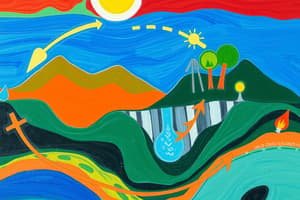Podcast
Questions and Answers
What role does phosphorus play in the growth of plants?
What role does phosphorus play in the growth of plants?
- It helps seedlings grow out of the soil. (correct)
- It reduces the need for sunlight.
- It primarily affects the color of flowers.
- It enhances the taste of fruits.
Which process contributes to the breakdown of rocks into smaller particles?
Which process contributes to the breakdown of rocks into smaller particles?
- Deposition
- Erosion
- Weathering (correct)
- Sedimentation
In the phosphorus cycle, what happens to phosphorus released from organic sources?
In the phosphorus cycle, what happens to phosphorus released from organic sources?
- It converts to inorganic phosphorus available for plant uptake. (correct)
- It gets leached into the ocean and remains there permanently.
- It immediately becomes part of sedimentary rock.
- It is lost to the atmosphere through gaseous processes.
What is a consequence of eutrophication in aquatic systems?
What is a consequence of eutrophication in aquatic systems?
What natural process prevents phosphorus from being reintroduced into the ecological system?
What natural process prevents phosphorus from being reintroduced into the ecological system?
Which factor contributes to the nutrient pollution in Lake Champlain?
Which factor contributes to the nutrient pollution in Lake Champlain?
How does climate change impact the phosphorus cycle?
How does climate change impact the phosphorus cycle?
What is the primary storage form of phosphorus in the environment?
What is the primary storage form of phosphorus in the environment?
What does residence time represent in a matter cycle?
What does residence time represent in a matter cycle?
Which component primarily characterizes the sources in a nutrient cycle?
Which component primarily characterizes the sources in a nutrient cycle?
Which ecosystem conditions significantly influence the speed of matter cycles?
Which ecosystem conditions significantly influence the speed of matter cycles?
What role does the lithosphere play in the carbon cycle?
What role does the lithosphere play in the carbon cycle?
How is carbon primarily stored in the oceans?
How is carbon primarily stored in the oceans?
What factor primarily affects how much carbon the oceans can hold?
What factor primarily affects how much carbon the oceans can hold?
Which process is part of the biological carbon pump in the ocean?
Which process is part of the biological carbon pump in the ocean?
What is a sink in the context of matter cycles?
What is a sink in the context of matter cycles?
What is the primary function of the physical carbon pump in the ocean?
What is the primary function of the physical carbon pump in the ocean?
Which process contributes to carbon cycling through tectonic activity?
Which process contributes to carbon cycling through tectonic activity?
What is the main effect of increased CO2 levels on stomata in plants?
What is the main effect of increased CO2 levels on stomata in plants?
How does ocean acidification primarily affect coral reefs?
How does ocean acidification primarily affect coral reefs?
What happens to carbon stored in dead organic matter in soil?
What happens to carbon stored in dead organic matter in soil?
What impact does tilling land have on soil carbon release?
What impact does tilling land have on soil carbon release?
In which way does increased atmospheric CO2 affect plant yield?
In which way does increased atmospheric CO2 affect plant yield?
What is one of the primary functions of phosphorus in living organisms?
What is one of the primary functions of phosphorus in living organisms?
What human activity can accelerate the phosphorus cycle?
What human activity can accelerate the phosphorus cycle?
What is a consequence of fish being exposed to acidic ocean waters?
What is a consequence of fish being exposed to acidic ocean waters?
How does the carbonate carbon pump contribute to the carbon cycle?
How does the carbonate carbon pump contribute to the carbon cycle?
What is a significant environmental consequence of whaling as mentioned in regard to ocean health?
What is a significant environmental consequence of whaling as mentioned in regard to ocean health?
Flashcards
Matter Cycle
Matter Cycle
A continuous process where matter changes form and combines with other elements, moving through different compartments or reservoirs on Earth.
Storage Pools/Compartments
Storage Pools/Compartments
Specific locations where matter accumulates and resides in a cycle, such as the atmosphere, ocean, or soil.
Source (in a cycle)
Source (in a cycle)
A reservoir that releases more nutrients than it stores.
Sink (in a cycle)
Sink (in a cycle)
Signup and view all the flashcards
Residence Time
Residence Time
Signup and view all the flashcards
Carbon Cycle
Carbon Cycle
Signup and view all the flashcards
Lithosphere
Lithosphere
Signup and view all the flashcards
Ocean Carbon Activity
Ocean Carbon Activity
Signup and view all the flashcards
Physical Carbon Pump
Physical Carbon Pump
Signup and view all the flashcards
Biological Carbon Pump
Biological Carbon Pump
Signup and view all the flashcards
Phosphorus Cycle
Phosphorus Cycle
Signup and view all the flashcards
Phosphorus Storage
Phosphorus Storage
Signup and view all the flashcards
Phosphorus in Soil
Phosphorus in Soil
Signup and view all the flashcards
Eutrophication
Eutrophication
Signup and view all the flashcards
Phosphorus Runoff
Phosphorus Runoff
Signup and view all the flashcards
Bioavailable Phosphorus
Bioavailable Phosphorus
Signup and view all the flashcards
Phosphorus in Aquatic Ecosystems
Phosphorus in Aquatic Ecosystems
Signup and view all the flashcards
Limiting Factor
Limiting Factor
Signup and view all the flashcards
Carbonate carbon pump
Carbonate carbon pump
Signup and view all the flashcards
Ocean Acidification
Ocean Acidification
Signup and view all the flashcards
Soil Organic Carbon
Soil Organic Carbon
Signup and view all the flashcards
Stomata
Stomata
Signup and view all the flashcards
Ocean Carbon Uptake
Ocean Carbon Uptake
Signup and view all the flashcards
Ecosystem Story Map
Ecosystem Story Map
Signup and view all the flashcards
Coral Reefs
Coral Reefs
Signup and view all the flashcards
Whaling Impact
Whaling Impact
Signup and view all the flashcards
Study Notes
Matter Cycles
- Matter is anything with mass that occupies space; it can change form and combine with other elements to form different molecules.
- Matter cycles, also known as nutrient cycles or biogeochemical cycles, are biological, geological, and chemical processes in ecosystems.
- Key concepts:
- Storage pools/compartments: Areas where matter accumulates.
- Sources: Release more nutrients than they absorb.
- Sinks: Absorb more nutrients than they release.
- Fluxes: Movement of matter into and out of compartments (can vary greatly).
- Residence time: Average time a molecule stays in a pool (calculated by total matter divided by outflow rate).
- Carbon's residence time in the atmosphere is 5-7 years.
- Matter cycle speeds vary by season and ecosystem type, often faster in spring than winter.
- Soil stores significant carbon; tropical soils like Amazonian ones cycle dead organic matter quickly.
- Cycles are categorized by their primary matter form (e.g., gaseous vs. sedimentary).
Carbon Cycle
- Carbon is essential for life on Earth.
- Major reservoirs/storage pools:
- Lithosphere (99.999% of Earth's carbon stored here, mostly unavailable),
- Ocean,
- Atmosphere,
- Biosphere.
- Carbon enters the atmosphere mainly from decaying matter.
- Carbon is incorporated into sedimentary rock through accumulation of decaying organisms.
- Fluxes:
- Tectonic activity releases carbon.
- Burning fossil fuels also releases it.
- Ocean-atmosphere gas exchange.
- Ocean carbon storage:
- Warmer water holds less dissolved carbon.
- Ocean currents, wind, and wave action affect carbon uptake.
- Pathways:
- Physical carbon pump: Surface waters move carbon deeper in the ocean.
- Biological carbon pump: Plankton convert dissolved carbon to organic matter, which sinks to the bottom when dead.
- Carbonate carbon pump: Shell-building organisms take in carbon, which sinks and forms sedimentary rock.
- Soil organic matter contains twice the carbon as the atmosphere.
Human Impact on the Carbon Cycle
- Tilled land releases more carbon into the air than no-till methods do.
- Increasing atmospheric CO2:
- Reduced transpiration in plants (smaller stomata).
- Decreased nutrient content in plants (5-14% reduction).
- Ocean acidification: Reduced pH impacting shell-building organisms and fish (hearing/smell).
Phosphorus Cycle
- Phosphorus is essential for life and stored primarily in sedimentary rock.
- Crucial for plant growth (roots, seedlings, stems) and animal processes (bones, teeth, DNA).
- Major surface pools:
- Sedimentary rock, soils, water bodies, and biosphere.
- Key processes:
- Weathering (breaks down rock to release phosphorus).
- Inorganic to organic conversion in terrestrial systems (from soil to plants to animals).
- Runoff, erosion, and leaching carry phosphorus in aquatic systems; it dissolves, becoming biologically available before potentially becoming sediments.
Eutrophication (Excess Phosphorus)
- Eutrophication is excessive nutrient accumulation (often phosphorus).
- Impacts:
- Algal blooms: Algae overgrow, causing oxygen depletion when they die.
- Reduced sunlight penetration for plant life.
- Issues in aquatic environments (Lake Champlain).
Ecosystem Story Map Assignment
- 4-page, single-spaced assignment.
- Include at least one photo per location.
- Flexible formatting, integrating photos with descriptions.
Studying That Suits You
Use AI to generate personalized quizzes and flashcards to suit your learning preferences.




